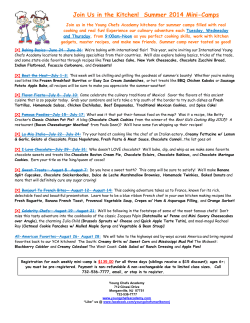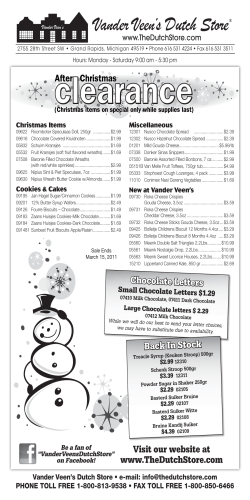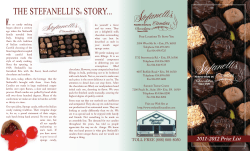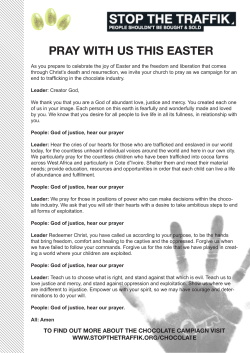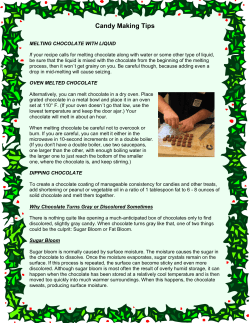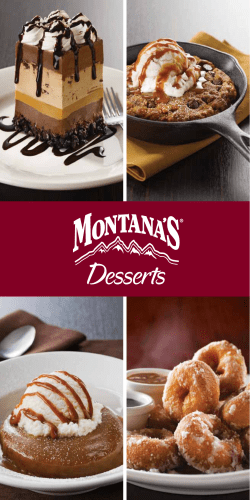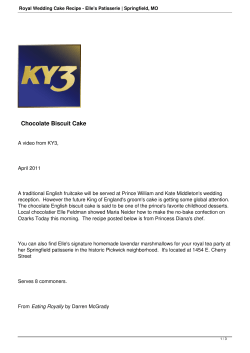
Confronting Confectionery new product trends
new product trends Confronting Confectionery Chocolate lovers are certainly not afraid of the dark, and sour flavors are driving sales of confections for adults and children. The candy market continues to grow, capitalizing on the latest trends and benefiting from a number of ingredient innovations. Marcia Mogelonsky, Contributing Editor A mericans love candy, purchasing more than $27 billion of it in 2005. Additionally, the outlook for 2006 is very sweet indeed: the National Confectioners Association (NCA) predicts confectionery sales in the U.S. were close to $29 billion by the end of 2006. The sales encompass all types of candy: chocolate, gum, mints and the wide range of non-chocolate confectionery products that includes gummies, licorice and other sweets. Retail sales of confectionery in the U.S. topped $27.9 billion by the end of 2005, according to the NCA. This represents a one-year increase of 1.8%. Chocolate confectionery was the top seller, racking up $15.7 billion in sales (up 2% over 2004), while non-chocolate candy saw sales of $8.7 billion (up 0.9%) and sales of gum totaled $3.5 billion, a oneyear increase of 4.1%. The buzzwords for chocolate confectionery in the past year are dark, darker and darkest. Also driving sales are gourmet and premium chocolate (most of which tends to be dark), chocolate with high cocoa content (dark again) and singleorigin chocolate (and dark once more). Sales of dark chocolate topped $1.62 billion in 2005, more than 10% of the overall chocolate market, which includes everything from mass marketed chocolate bars to handmade truffles. This represents an increase of 28% since 2003. Gourmet or premium chocolate sales amounted to $1.79 Leading the innovation billion in 2005, an increase of 28% since 2003. Almost wave among confections are all gourmet/premium chococompanies that specialize in late is dark, and almost all dark chocolate is gourmet/ child-targeted products, premium. However, there are including many novelty items. some small exceptions, many of which lean heavily on concepts rather than products. The major focus in the chocolate industry is in terminology: how does one define gourmet or premium chocolate, and where is the dividing line between mass market and gourmet/premium? Some key factors are accepted by all. First, it is acceptable to use the terms “gourmet” and “premium” interchangeably. These higher-quality chocolates are usually, but not always, dark (containing a higher cocoa content than mass market products). They also are distinguished by their price, quality, consumer perception and, to an extent, their retail positioning. A definition gaining acceptance in the market is that premium or gourmet chocolate retails for $8 per pound or more (which equates to about $0.50 per ounce), but there are different thresholds for different types of premium chocolate: products that retail for between $8 and $16 per pound are www.PreparedFoods.com ● January 2007 11 new product trends Low Carb Limited-edition products are something of a “test” to see if consumers will accept a new flavor, texture, and… Great Masking color or package. Such is the case with Skittles, which The perfect ingredient for your features a limited-edition low carbohydrate products. ice cream variety. BeFlora Plus® has an oligofructose base so it considered “mass premium products,” those meant to attract consumers who may be unfamiliar with the premium chocolate market and reluctant to invest in it. “Mass premium” products are priced also to be an affordable luxury for consumers wanting a reward or a special treat on an ordinary day: they are fancy without being too fancy, elegant, but not outrageously priced. Super premium products, on the other hand, come with super premium prices. Artisanal, hand-made chocolates and truffles tend to be perishable and precious: some even come topped with real gold leaf or other expensive ingredients. These products are special—not everyday special, but very special. performs almost identically to sugar in most applications. It allows for a 10:1 substitution of sugar and is excellent for blending with Origin Stories high intensity Another point of differentiation in the chocolate universe is the source of the cacao used to make the product. The key phrase is “single origin,” and the concept is similar to that used to identify fine wine and gourmet coffee. The term refers to the origin of the cocoa variety used for producing the chocolate. If that can be reduced to a well-defined territory, region, country or even plantation, then the chocolate made with this special variety of cocoa beans can be described as a single-origin chocolate. Like fine wine or gourmet coffee, single-origin chocolate’s pedigree allows for a point of differentiation from the “everyday brands.” Think Sumatra instead of drip coffee or Shiraz instead of red wine. The moniker gives the product cachet; the taste is distinctive, and the price can go sky high if the source is rare enough. In the late 1980s, Valrhona, Lindt and other top European chocolatiers began identifying their products by origin; the trend has gained traction in the past couple of years, as the passion for quality chocolate has grown. Single-origin chocolates are appearing as bars (Dagoba’s Sambirano 65% Single Origin Madagascar) and as single pieces (as in the “tasting kit” of single-origin chocolates by La Maison du Chocolat). improve taste. Or, it can sweeten on its own. It also has great masking properties for even more improved taste. Request a Chocolate as Health Food For many chocoholics, the health benefits of dark chocolate provide a welcome justification for their habit. Indeed, much scientific effort has been expended in proving that chocolate is a legitimate “health food.” While it may not find its way onto any “superfood” list, dark chocolate is credited with being an antioxidant, a product that can be beneficial in reducing high blood pressure and the risk of heart disease. The scientific findings emphasize that only dark chocolate (not milk chocolate or white chocolate) has this nutritional benefit. For chocolate lovers, there is sweeteners to sample now for Sweet It Out your product Number of New Sugar Confectionery Products* Launched in the U.S., 2000-2005 2005 2004 2003 2002 2001 2000 842 873 731 678 879 616 * Excludes chewing gum and chocolate, includes mints Source: Mintel’s GNPD development projects. 1300 N. Market Street Suite 401 Wilmington, DE 19801 302-778-4166 www.roxlor.com www.PreparedFoods.com ● January 2007 new product trends Some limited-edition products cycle also a caveat: while dark chocolate potentially can be beneficial, the benefits must be weighed against the fat and calorie “negatives.” through stores quickly, but others meet the fate of Mega M&Ms; what began as a limited-edition tie-in product has become a long-term proposition. Dandy Candy Chocolate confectionery has seen major growth over the past year, but non-chocolate confectionery has not been resting on its laurels. Sugar-free candy, new flavors and types of licorice, single-serve seasonal offerings and limited-edition packages are all top of mind for candy connoisseurs. Sales of non-chocolate confectionery increased 17% between 2003 and 2005, to a total of $8.9 billion. The category thrives on innovation, as demonstrated by the fact that more than 700 new non-chocolate candy and mint products have been introduced per year since 2000 on average, according to Mintel’s GNPD. Market-leading companies are not necessarily the top innovators: leading the innovation wave are companies that specialize in products for children, including many novelty items. These companies are challenged continuously to keep up with children’s rapidly changing tastes. Many of their products feature tie-ins with popular children’s movies, TV shows and video games, and these companies must adapt continually to remain current with the latest trends. As an example, consider the innovations presented by CAP Candy, a subsidiary of Hasbro. CAP Candy launched 187 new sugar confectionery products between 2000 and 2005, most of them novelty items such as Harry Potter Fizzing Whizbees popping candy and Incredibles Pic-Tastix 3D Lollipops. The number-two company in terms of new product launches was Au'some Candies, a subsidiary of Hong Kongbased Candy Novelty Works Limited. One of the largest "interactive candy" manufacturers in the world, the company’s recent introductions include a Kong candy dispenser (which emits gorilla roars and has eyes that flash), and a Nintendo Marshmallow Jelly Pop featuring Mario Brothers characters. Making the ordinary special is a challenge, but candy manufacturers have found a way to take a favored but unexciting product and give it a new spin. Limitededition candies—such confections as Icy Burst Starburst and Ice Cream Skittles—become collectors’ items because of their short 14 January 2007 ● www.PreparedFoods.com Extreme Flavors: Sour, Sweet, Tropical and More The intensity battle continues. While some parents may have hoped that the mouth-puckering trend would have died down by 2006, the quest for the most sour, most extreme candy flavor continues. Strong flavors, combining a hint of sour and spice or sour and sweet, are turning up in candies for kids and adults. Altoids, one of the first products to pioneer the concept of extremely strong-flavored mints, has added to its line of sour candies—moving from orange to mango and raspberry. These adult-positioned sour treats may be considered tame beside some of the kid-focused sour candies on the market: Hershey’s Jolly Rancher Sour Bolt Blasts, which have an extremely sour powder inside a sour hard shell, come in a host of “sour” flavors. Vying for the “sourest candy award” are Jolly Rancher Double Blasts, which have one flavor in the hard shell and another infused in the powdered candy center. Flavors include cherry/orange, blue raspberry/lime, strawberry/apple and Sales of Premium and Dark Chocolate, mango/lemon. 2003-2005, in Billions Not all extreme flavors are sour: Premium Chocolate Dark Chocolate tropical tastes, which have made their way through a number of other 2005 $1.79 $1.62 food products such as beverages 2004 $1.56 $1.41 and ice cream novelties, are appear2003 $1.40 $1.26 ing in candy as well: Hershey’s Life Savers Crème Savers have line Source: Mintel/National Confectioners Association extensions including Crème Savers Dark Continent Limited Editions shelflife. While finding space for these temporary items in an already-crowded candy aisle can be challenging for category managers, many manufacturers are helping retailers find space for these new items by offering display vehicles which themselves can become sought-after collectibles. Limited-edition products have advantages for manufacturers as well as consumers. The products become their own “test” to see if consumers will accept a new flavor, texture, color or package. While some limited-edition products may cycle through the stores quickly, others meet with enough acceptance to extend their stay. Such is the case with Mega M&Ms, which began as a limited-edition tie-in product and now has become a long-term proposition. new product trends Tropicals available in multi-serve bags of Pina Colada & Crème, Banana & Crème and Mango & Crème. Chew on This New product innovations are not restricted to hard candy: licorice and caramel candies have seen sales grow significantly over the past year, and new product launches also are increasing. Hershey extended its line of Twizzlers, which for years were available only in strawberry, cherry and traditional black licorice flavors. Twizzlers Rainbow Twists has six distinct flavors and colors including grape, blue raspberry, watermelon, lemonade, orange and strawberry. Taking the candy out of the package is another new departure: American Licorice Co. partnered with 7-Eleven this year to provide edible cherryflavored drinking straws to accompany the c-store’s Slurpees. Making a straw a candy is not the only twist: other products are being transformed as well. Goetze’s Candy Company’s classic Cow Tales caramel chew now is available in strawberry as well as the original caramel flavor. Also new is Tootsie Roll’s Sugar Mamas, twistwrapped pieces of soft, chewy caramel. Sugar-free Gains Ground Sugar-free confectionery, be it chocolate, non-chocolate, mint or gum, is gaining traction, as more adults try to indulge without overdoing. According to the NCA, sales The quest for the most sour, most extreme candy flavor continues. Strong flavors, combining a hint of sour and spice or sour and sweet, are turning up in candies for kids and for adults. See Food Master-INGREDIENTS, p. 98 16 January 2007 ● www.PreparedFoods.com new product trends High Impact, High Intensity, True-to-Fruit Flavors for Confections and Chewing Gum At Takasago we focus on key markets, including confections and chewing gum. Our dedication to success is demonstrated through exceptional high impact, high intensity Vivid flavors™ and sensates. Our commitment is evident in the strategic, ongoing expansion of our US facilities. • New, dedicated confectionery application laboratories, focused on new product development • Consumer Insight & Marketing Research: focused on collaborating with consumers to develop winning flavors • New Sensory Testing Center: focused on identifying the taste trends that lead to market success At Takasago, it’s all about focusing on the things that we do best…including working with you to create breakthrough confectionery products. Call us today at 201-784-7311 or email [email protected] Hershey extended its line of Twizzlers with Rainbow Twists, six distinct flavors and colors including grape, blue raspberry, watermelon, lemonade, orange and strawberry. of sugar-free chocolate have declined over the past year, but sales of sugarfree, non-chocolate candy and sugarfree gum both have increased. Overall, sales of sugar-free confectionery through food, drug and mass merchandiser channels topped $986 million in 2005. While sugar-free chocolate has not done well against strong premium and dark chocolate competition, the losses in that sub-segment are outweighed by major gains in sugar-free candy and gum. The major forces behind the increase in sales come from a combination of health and diet trends, as well as improvements in sugar substitutes. The incidence of Americans with diabetes—20.8 million according to the American Diabetes Association—no doubt has helped grow sugar-free candy sales. Concerns with obesity also have driven consumers to find less-fattening ways to indulge. A new range of sugar substitutes has attracted consumers to diet candy. New sweeteners such as sucralose and xylitol have helped improve the taste of diet candy—and the enthusiasm for it. Among the big players who have embraced the sugar-free market are Nestlé, Hershey and Storck USA, all of which introduced sugar-free versions of their most popular candy brands, including Nips, Werther’s, Jolly Rancher and Twizzlers. New Products Push Gum Sales Sales of gum (both sugared and sugar-free) increased just under 9% between 2003 and 2005 through food, drug and mass merchandiser channels, bringing the market for these products to $958 million. An influx of new products, including Wrigley’s Orbit in 2001, Hershey’s Ice Breakers in 2002 and Cadbury’s Dentyne Fire in 2003, fueled growth. The majority of new gum introductions during this period were in the sugarless sector. New sugar substitutes sucralose and xylitol gave sugarless gum an edge in terms of taste, longer-lasting flavor and cavity prevention. The introduction of new flavors helped generate news and bolster sales, especially in the sugar-free segment. Sugar-free gum makers took a lesson from the success of Altoids (the “curiously strong mint”) and began introducing their own intense mint-flavor products, such as Wrigley’s Eclipse and Hershey’s Ice Breakers. Many sugar-free gum brands capitalized on the popu- January 2007 ● www.PreparedFoods.com new product trends larity of fruit in candy products by adding new fruit flavors that appeal to kids, teens and Hispanics. Sour flavors now are becoming more popular, evidenced by new introductions like Wrigley’s Juicy Fruit Tropikiwi Kick and Altoids Sour Chewing Gum. For consumers seeking unique flavors, gum makers have begun creating unusual combinations like Orbit Citrusmint and Dentyne Vanilla Ice. While sugar-free gum sales increased, sales of sugared gum were relatively flat between 2003 and 2005. While some players decided to switch to sugar-free rather than fight the sugared gum fight, others stepped up efforts with existing regular gum brands: Wrigley continued to invest in and grow two of its biggest youth-targeted brands, Juicy Fruit and Hubba Bubba. Sales of Juicy Fruit brand have been reinvigorated through the introduction of a new pellet form, as well as unique, new flavors including Strappleberry, Grapermelon and Tropikiwi Kick, the first sour Juicy Fruit flavor, introduced in 2005. Wrigley’s Hubba Bubba bubblegum brand also grew sales, thanks to the 2004 introduction of Hubba Bubba Max Cherry-Lemonade and the 2005 launch of Bubble Tape Triple Treat. Room for More The confectionery industry is constantly changing to meet the desires of a fad-conscious public. The industry did well during the low-carb fad and was able to regroup when the fad faded and to continue growth. New challenges include growing anxiety in the nation about the obesity crisis and the growth of Type 2 diabetes among adults and children. Other issues facing the industry are the demographic changes that have led to an increasing senior population and a declining child and tween population, changing the dynamic between chocolate and non-chocolate confectionery. An increasingly blurred retail arena has led to the availability of confectionery in multiple channels—one can buy candy in just about every outlet from the convenience store and movie theater (where one would expect to find candy) to the bookstore, the auto parts store and even the big-box pet store. The possibilities for placing products in front of consumers are almost endless. The only trick is to have the right confectionery product in the right place at the right time. This article contains information from the Mintel reports “Seasonal Chocolate Confectionery—U.S., August 2006,” “Gum and Mints—U.S., January 2006,” “Sugar Confectionery—U.S., May 2006” and “Premium Chocolate Confectionery—U.S. (forthcoming).” Please visit http://reports.mintel. com for more information or call Mintel at 312-932-0400. See Food Master-INGREDIENTS, p. 3 20 January 2007 ● www.PreparedFoods.com www.overseal.com Tastier strawberries with Talin® Enhancing flavours naturally to give you a longer lasting taste. Call 845-358-8600 or email [email protected] for more information Overseal is part of the Natraceutical Group PFX01074Overseal.indd 1 www.PreparedFoo ds.com 12/7/06 3:44:09 PM Signing up for (or renewing) a FREE subscription to Prepared Foods is so easy! Simply go to www.PreparedFoods.com and click on the "Free Subscriptions" link. We look forward to hearing from you! www.PreparedFoods.com ● January 2007 21
© Copyright 2026
